Experimental Study and Numerical Simulation of Removing Water Blocking by Hot-Gas Injection in Tight Cores
Abstract
:1. Introduction
2. Experimental Study on Influencing Factors of Removing Water Block Effects by Hot-Gas Injection in Tight Cores
2.1. Experimental Steps and Methods
2.2. Evaluation of the Effect of Removing Water Block by Injecting Hot Gas
2.2.1. Influence of Gas-Injection Temperature
2.2.2. Influence of Water Block Degree
3. Numerical Simulation of Hot-Gas Injection
- (1)
- The temperature distribution is uniform at the initial time;
- (2)
- The stress sensitivity on the permeability can be ignored;
- (3)
- The gravity effect is ignored;
- (4)
- Homogeneous porosity and permeability distribution in the core;
- (5)
- Constant injection rate of methane and carbon dioxide at the inlet boundary.
- (6)
- The outlet boundary is set as constant pressure boundary with pressure equal to 1 atm.
- (7)
- The initial water phase of the core is in a static state, and the flow of the water phase follows the Darcy equation when it is driven by gas, and the effect of adsorbed water on the pore surface of the core on fluid flow is not considered.
3.1. Core Temperature Change
3.2. Residual Water Saturation
4. Conclusions
- (1)
- During the hot gas injection, with the increase of gas injection temperature, the recovery rate of core permeability increases. Compared with carbon dioxide, the effect of methane hydrolyzing water block is better. While with the increase of methane injection, the recovery rate of permeability increases, but its increasing trend slows down gradually.
- (2)
- The numerical simulation results for hot gas injection show that the temperature of carbon dioxide injection directly affects the core temperature, and the core temperature changes from the injection end, and the core temperature increases gradually.
- (3)
- With the injection of carbon dioxide, the residual water saturation of the core changes continuously, and remaining water saturation continuously decreases. It further illustrates the feasibility of drying by hot-gas injection.
Author Contributions
Funding
Institutional Review Board Statement
Informed Consent Statement
Data Availability Statement
Acknowledgments
Conflicts of Interest
References
- Jiang, Z.-X.; Li, Z.; Li, F.; Pang, X.-Q.; Yang, W.; Liu, L.-F.; Jiang, F.-J. Tight sandstone gas accumulation mechanism and development models. Pet. Sci. 2015, 12, 587–605. [Google Scholar] [CrossRef]
- Han, H.Y.; Wang, Z.Z.; Sun, X.X.; Wang, W.J. A New Method to Predict Favorable Gas-Rich Area in Tight Sandstone Gas Reservoir in Daniudi Area. Appl. Mech. Mater. 2013, 295, 3328–3332. [Google Scholar] [CrossRef]
- Huang, S.; Yu, C.; Gong, D.; Wu, W.; Liao, F. Stable Carbon Isotopic Characteristics of Alkane Gases in Tight Sandstone Gas Fields and the Gas Source in China. Energy Explor. Exploit. 2014, 32, 75–92. [Google Scholar] [CrossRef]
- Ma, X. “Extreme utilization” development theory of unconventional natural gas. Pet. Explor. Dev. 2021, 48, 381–394. [Google Scholar] [CrossRef]
- Siemek, J.; Nagy, S. Energy carriers use in the world: Natural gas-conventional and unconventional gas resources. Arch. Min. Sci. 2012, 57, 283–312. [Google Scholar]
- Lai, J.; Wang, G.; Wang, Z.; Chen, J.; Pang, X.; Wang, S.; Zhou, Z.; He, Z.; Qin, Z.; Fan, X. A review on pore structure characterization in tight sandstones. Earth-Sci. Rev. 2018, 177, 436–457. [Google Scholar] [CrossRef]
- Su, X.; Wang, Q.; Song, J.; Chen, P.; Yao, S.; Hong, J.; Zhou, F. Experimental study of water blocking damage on coal. J. Pet. Sci. Eng. 2017, 156, 654–661. [Google Scholar] [CrossRef]
- Bahrami, H.; Rezaee, R.; Clennell, B. Water blocking damage in hydraulically fractured tight sand gas reservoirs: An example from Perth Basin, Western Australia. J. Pet. Sci. Eng. 2012, 88, 100–106. [Google Scholar] [CrossRef]
- Mojarad, R.S.; Settari, A. Velocity-based Formation Damage Characterization Method for Produced Water Re-injection: Application on Masila Block Core Flood Tests. Pet. Sci. Technol. 2008, 26, 937–954. [Google Scholar] [CrossRef]
- Wang, J.; Zhou, F.-J. Cause analysis and solutions of water blocking damage in cracked/non-cracked tight sandstone gas reservoirs. Pet. Sci. 2020, 18, 219–233. [Google Scholar] [CrossRef]
- Holditch, S.A. Factors Affecting Water Blocking and Gas Flow from Hydraulically Fractured Gas Wells. J. Pet. Technol. 1979, 31, 1515–1524. [Google Scholar] [CrossRef]
- Bennion, D.B.; Thomas, F.B.; Ma, T. Formation Damage Processes Reducing Productivity of Low Permeability Gas Reservoirs. In Proceedings of the SPE Rocky Mountain Regional/Low-Permeability Reservoirs Symposium and Exhibition, Denver, CO, USA, 12–15 March 2000. [Google Scholar]
- Cimolai, M.; Gies, R.; Bennion, D.; Myers, D. Mitigating Horizontal Well Formation Damage in a Low-Permeability Conglomerate Gas Reservoir. In Proceedings of the SPE Gas Technology Symposium, Calgary, AB, Canada, 28–30 June 1993; p. SPE-26166-MS. [Google Scholar]
- Li, K.; Horne, R.N. Characterization of Spontaneous Water Imbibition into Gas-Saturated Rocks. In Proceedings of the SPE/AAPG Western Regional Meeting, Long Beach, CA, USA, 19–22 June 2001; pp. 375–384. [Google Scholar]
- Mahadevan, J.; Sharma, M.M.; Yortsos, Y.C. Evaporative cleanup of water blocks in gas wells. SPE J. 2007, 12, 209–216. [Google Scholar] [CrossRef]
- Abass, H.; Ortiz, I.; Khan, M.; Beresky, J.; Sierra, L. Understanding Stress Dependant Permeability of Matrix, Natural Fractures, and Hydraulic Fractures in Carbonate Formations. In Proceedings of the SPE Saudi Arabia Section Technical Symposium, Dhahran, Saudi Arabia, 7–8 May 2007; p. SPE-110973-MS. [Google Scholar]
- LLe, D.H.; Hoang, H.N.; Mahadevan, J. Gas Recovery from Tight Sands: Impact of Capillarity. SPE J. 2012, 17, 981–991. [Google Scholar] [CrossRef]
- Tian, J.; Kang, Y.; Luo, P.; You, L.; Zhang, D. A new method of water phase trapping damage evaluation on tight oil reservoirs. J. Pet. Sci. Eng. 2018, 172, 32–39. [Google Scholar] [CrossRef]
- You, L.; Kang, Y. Prediction of Water Phase Trapping Damage in Tight Gas Reservoirs. Flow in Porous Media-From Phenomena to Engineering and Beyond. In Proceedings of the International Forum on Porous Flow and Applications, Wuhan, China, 24–26 April 2009; pp. 568–573. [Google Scholar]
- Zhang, L.; Zhou, F.; Zhang, S.; Li, Z.; Wang, J.; Wang, Y. Evaluation of permeability damage caused by drilling and fracturing fluids in tight low permeability sandstone reservoirs. J. Pet. Sci. Eng. 2019, 175, 1122–1135. [Google Scholar]
- Davis, B.; Wood, W. Maximizing Economic Return by Minimizing or Preventing Aqueous Phase Trapping During Completion and Stimulation Operations. In Proceedings of the SPE Annual Technical Conference and Exhibition, Houston, TX, USA, 26–29 September 2004; p. SPE-90170-MS. [Google Scholar]
- Golman, B.; Takigawa, T.; Shinohara, K.; Ohzeki, K. Kinetics of liquid penetration into bottom edge of cast tape. Colloids Surf. A Physicochem. Eng. Asp. 2005, 254, 9–16. [Google Scholar] [CrossRef]
- Mirzaei-Paiaman, A.; Dalvand, K.; Kohshour, I.O.; Masihi, M.; Moghadasi, J. A Study on the Key Influential Factors of a Gas Reservoir’s Potential for Aqueous Phase Trapping. Energy Sources Part A Recovery Util. Environ. Eff. 2012, 34, 1541–1549. [Google Scholar] [CrossRef]
- Akin, S.; Schembre, J.; Bhat, S.; Kovscek, A. Spontaneous imbibition characteristics of diatomite. J. Pet. Sci. Eng. 2000, 25, 149–165. [Google Scholar] [CrossRef]
- Somerton, W.; Mehta, M.; Dean, G. Thermal Alteration of Sandstones. J. Pet. Technol. 1965, 05, 589–593. [Google Scholar] [CrossRef]
- Murphy, H. Thermal stress cracking and the enhancement of heat extraction from fractured geothermal reservoirs. U.S. Dep. Energy Off. Sci. Tech. Inf. 1978, 7, 22–29. [Google Scholar]
- Homandetienne, F.; Houpert, R. Thermally induced microcracking in granites-Characterization and analysis. Int. J. Rock Mech. Min. Sci. Geomech. Abstr. 1989, 26, 125–134. [Google Scholar] [CrossRef]
- Noh, M.H.; Firoozabadi, A. Wettability Alteration in Gas-Condensate Reservoirs to Mitigate Well Deliverability Loss by Water Blocking. SPE Reserv. Evaluation Eng. 2008, 11, 676–685. [Google Scholar] [CrossRef]
- Xiong, Y.; Mo, J.; Li, P.; Jiang, J.; Zhang, L. Difference analysis and evaluation of irreducible water drying reaction and drying effect in tight reservoir. Chem. Bull. 2018, 7, 646–652. [Google Scholar]
- Zhao, Y.; Liu, X.; Zhang, L.; Tang, H.; Xiong, Y.; Guo, J.; Shan, B. Gas-water flow law and reservoir desiccation mechanism of tight sandstone gas reservoir. Nat. Gas Ind. 2020, 9, 70–79. [Google Scholar]
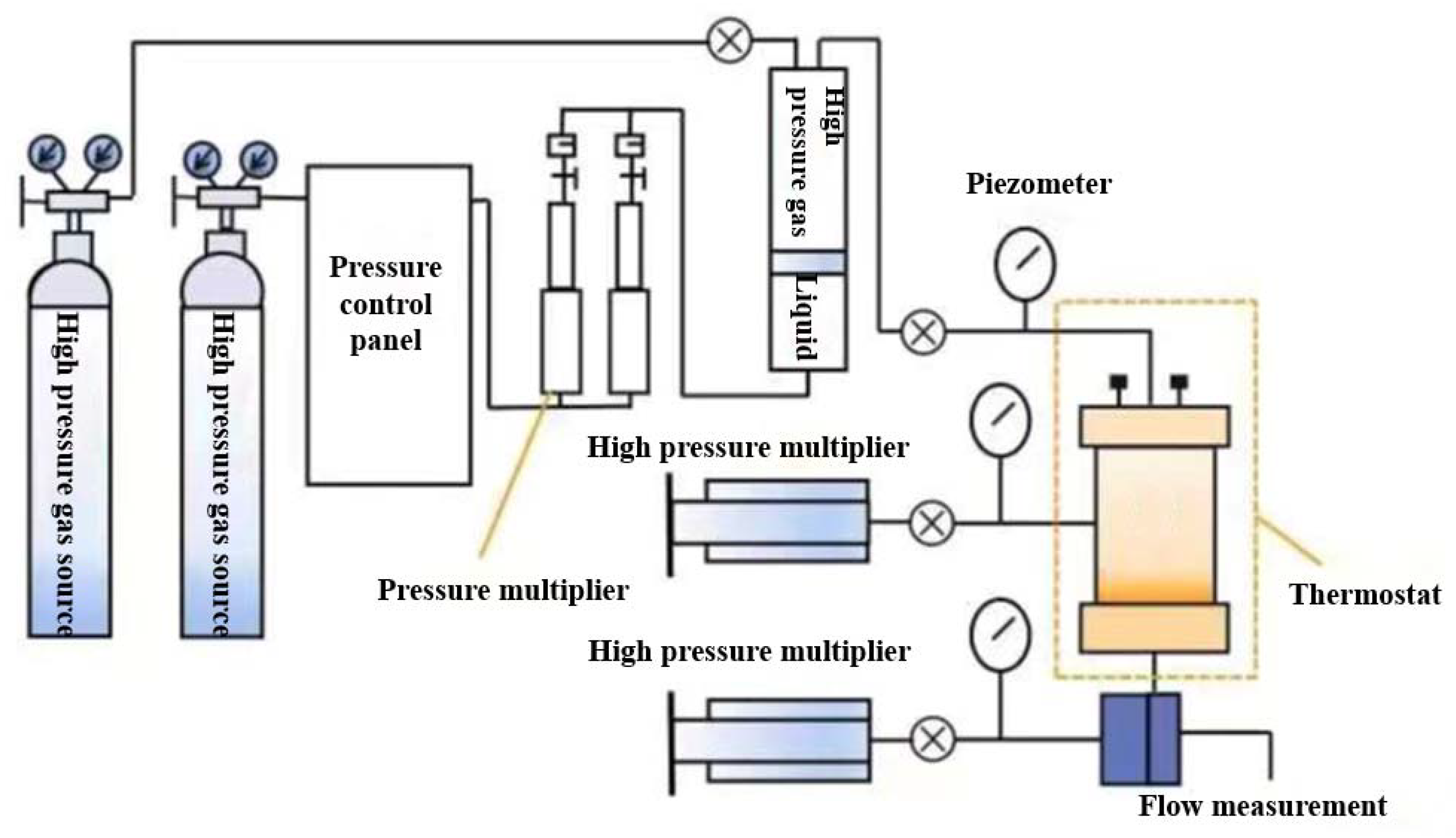
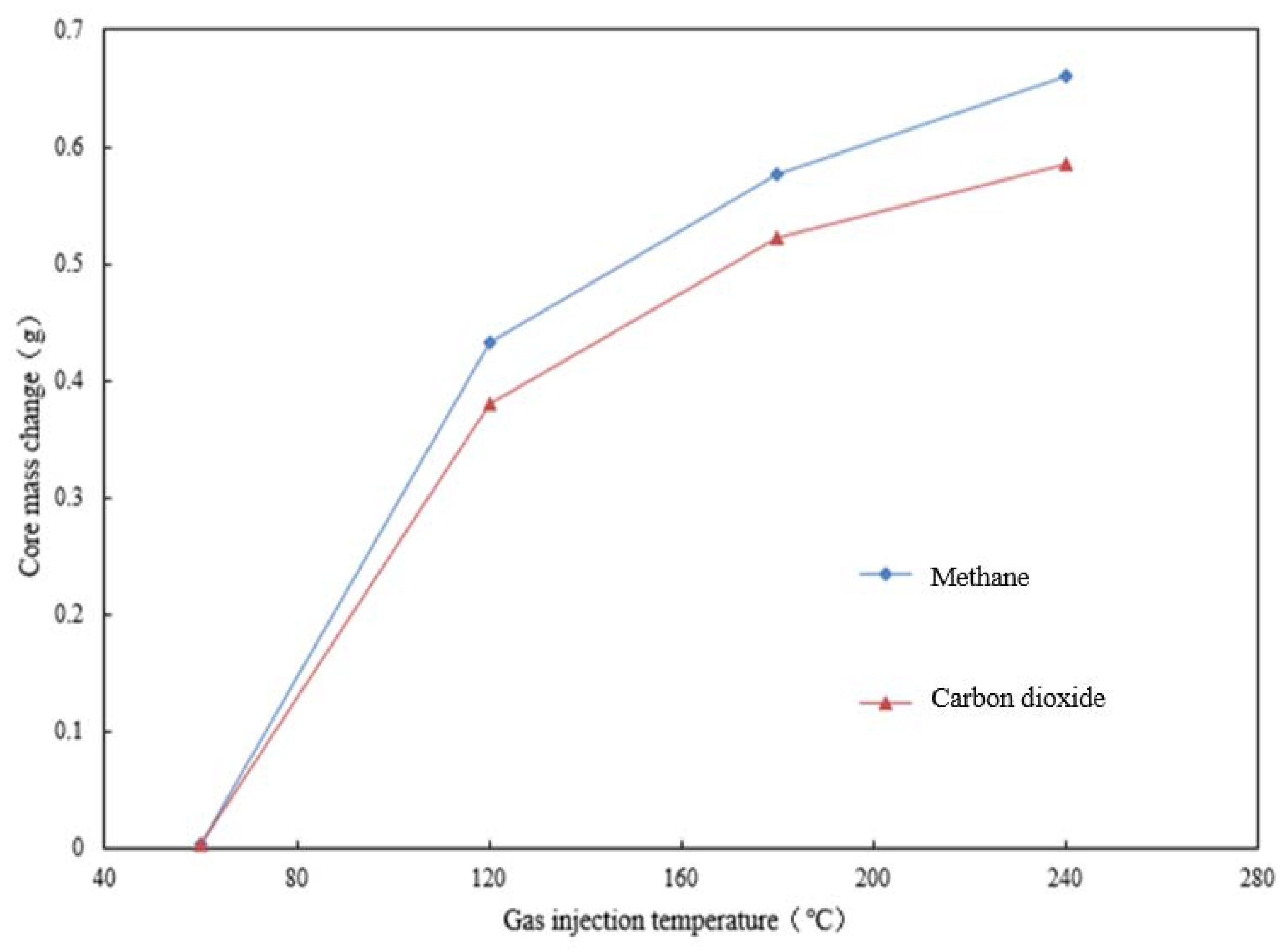
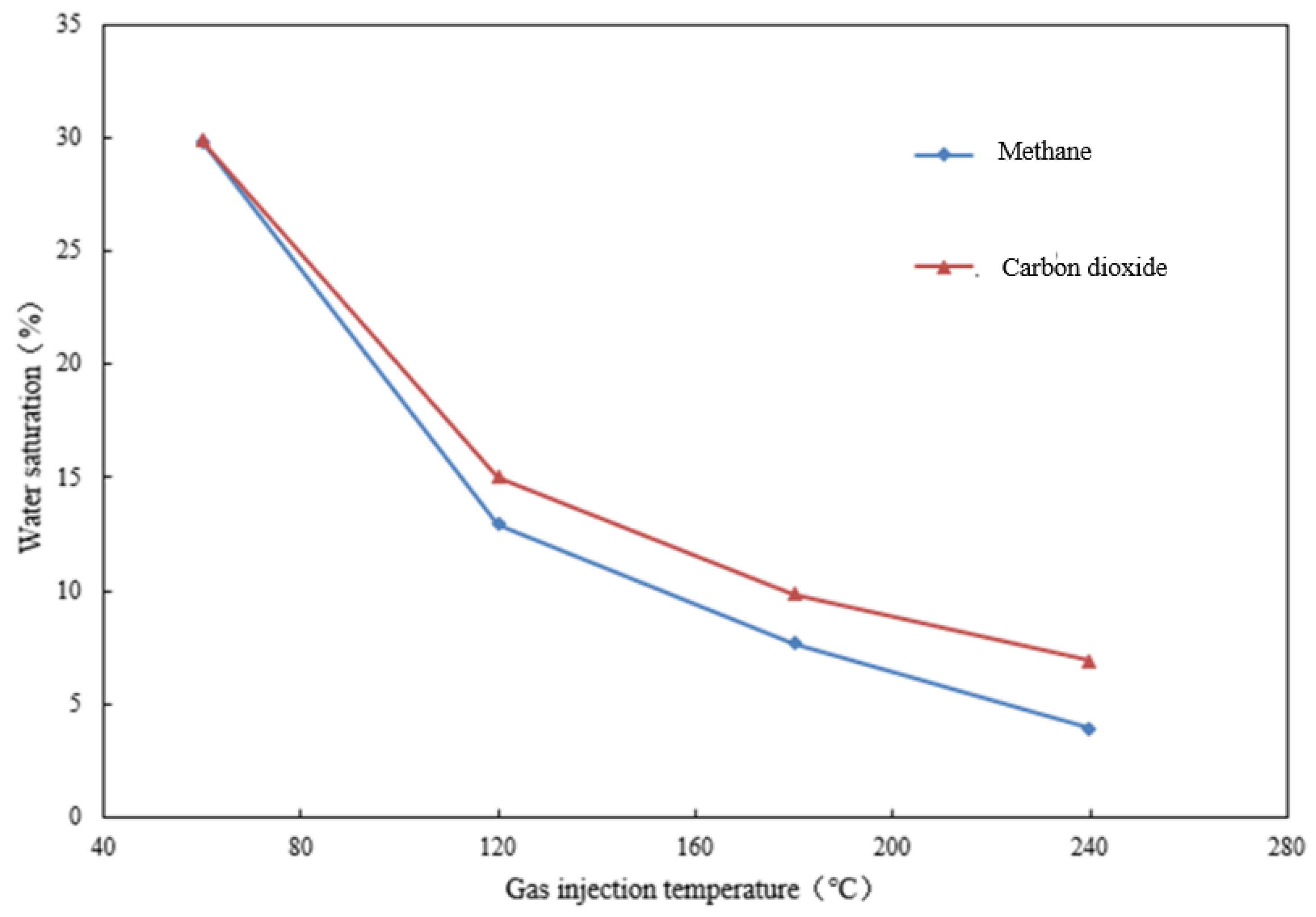
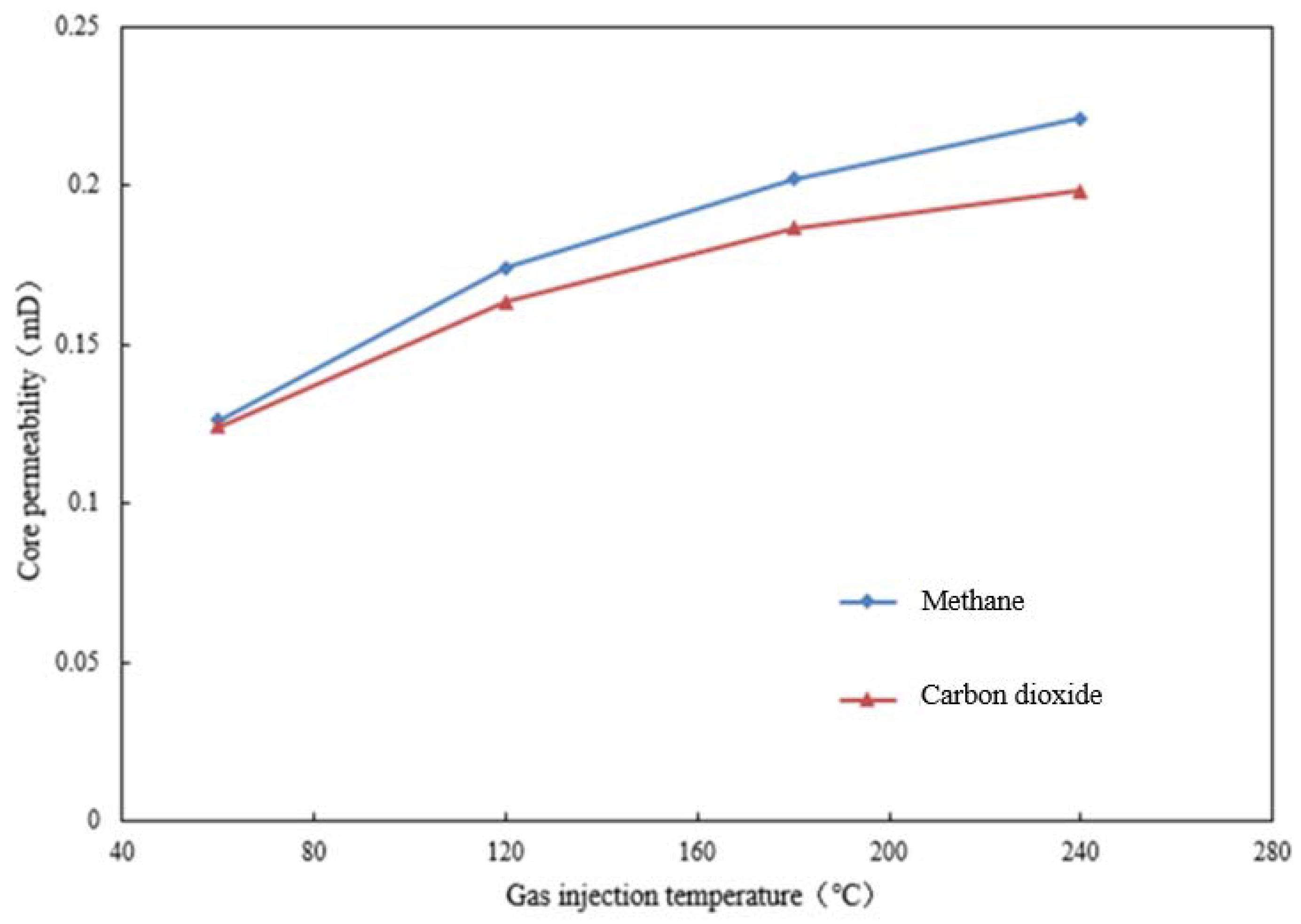
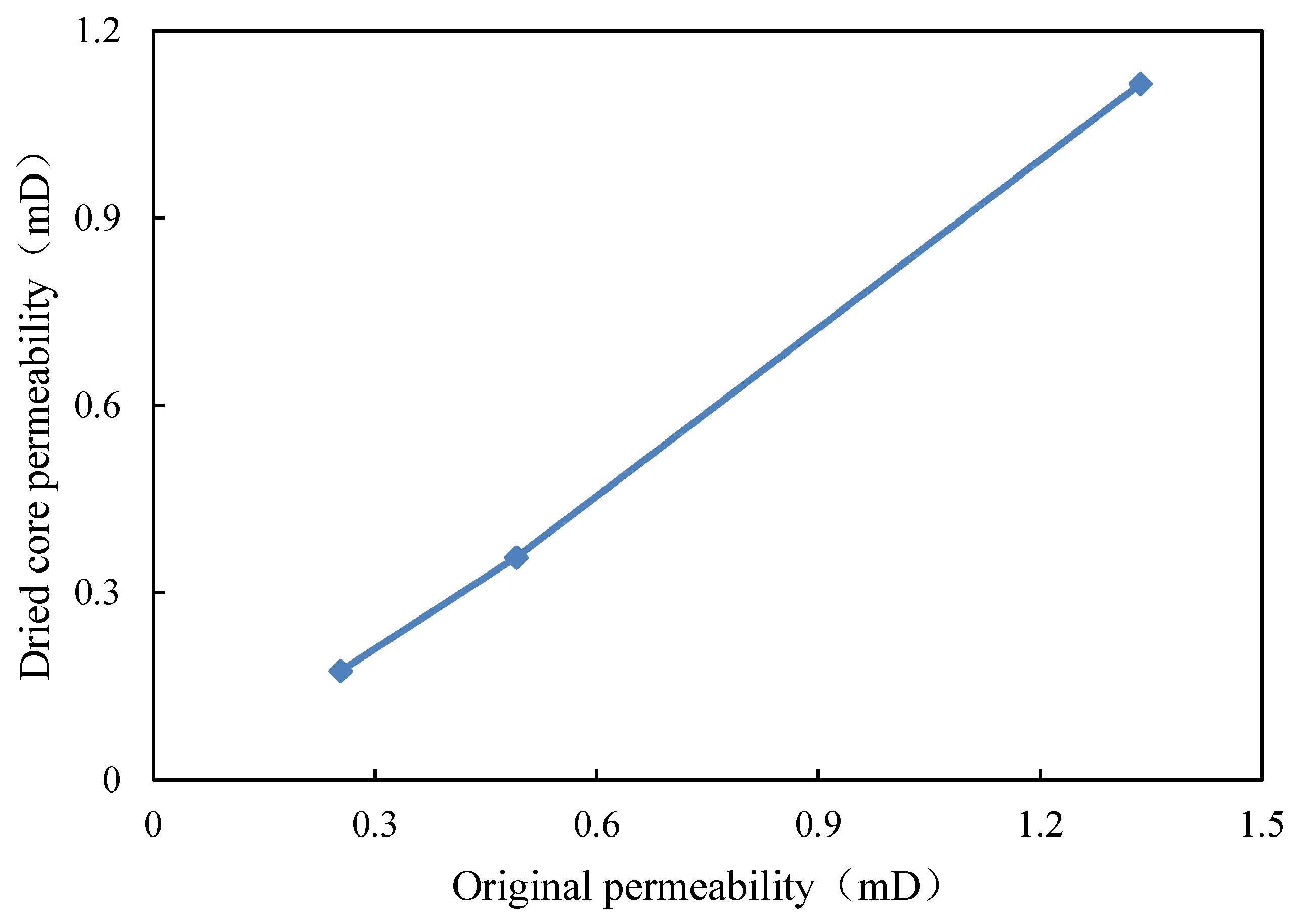
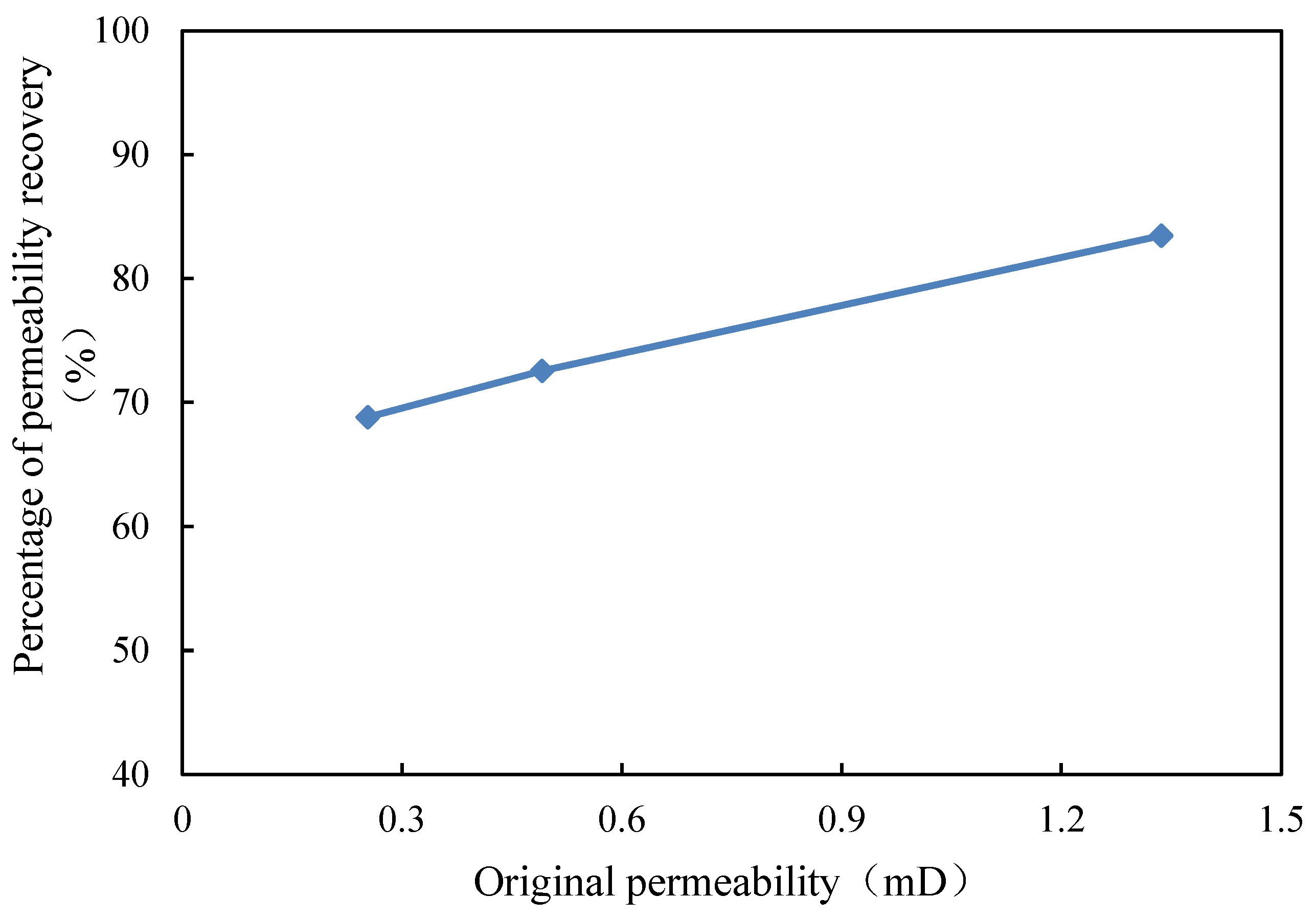
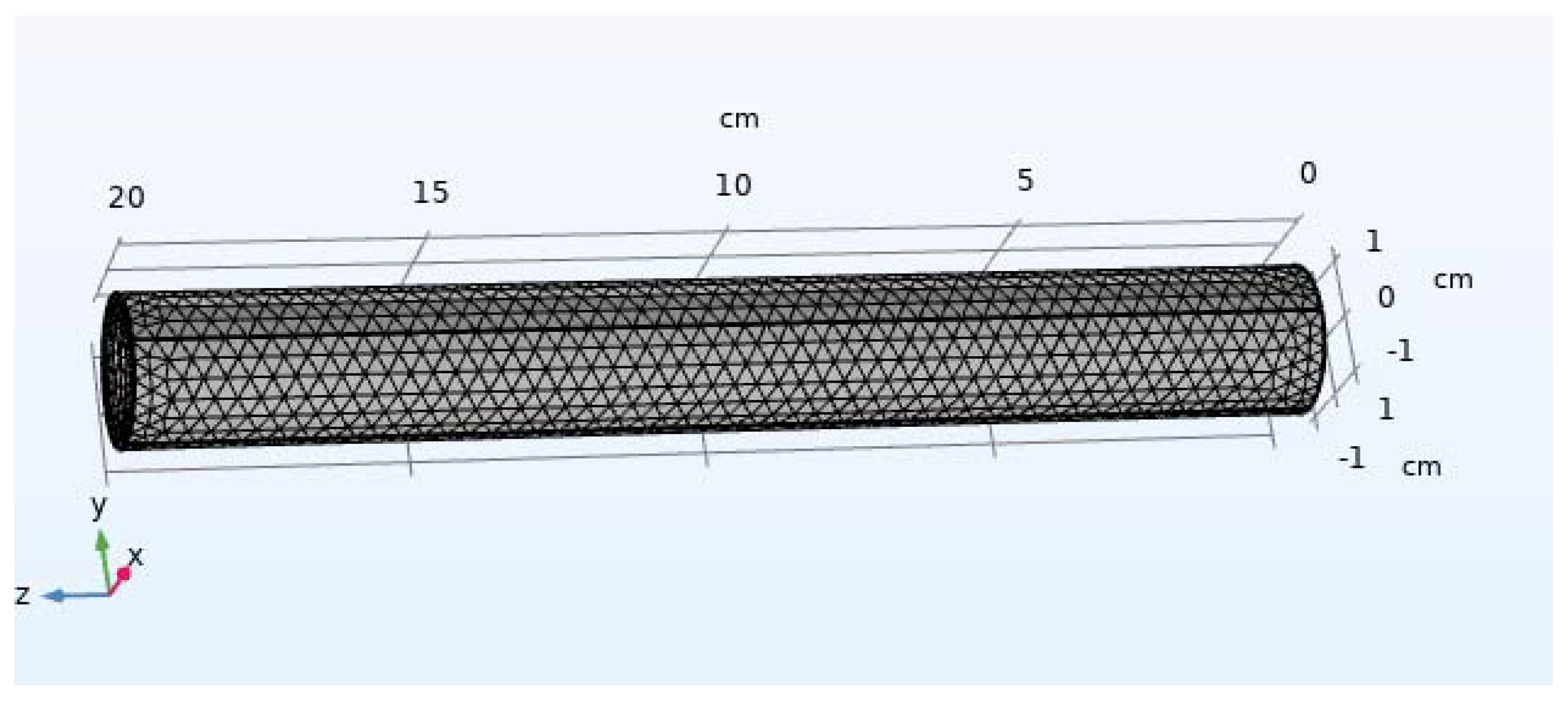


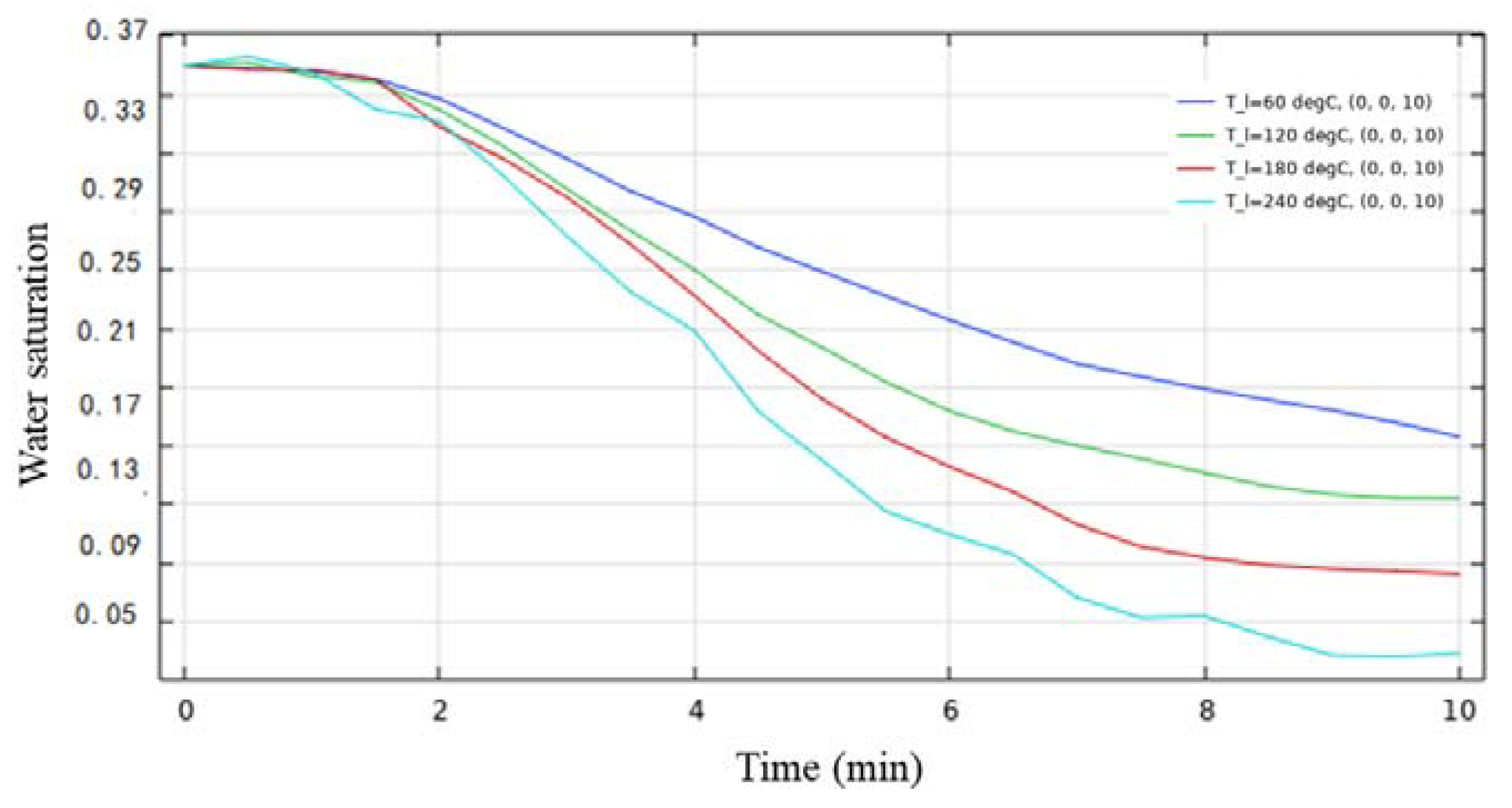
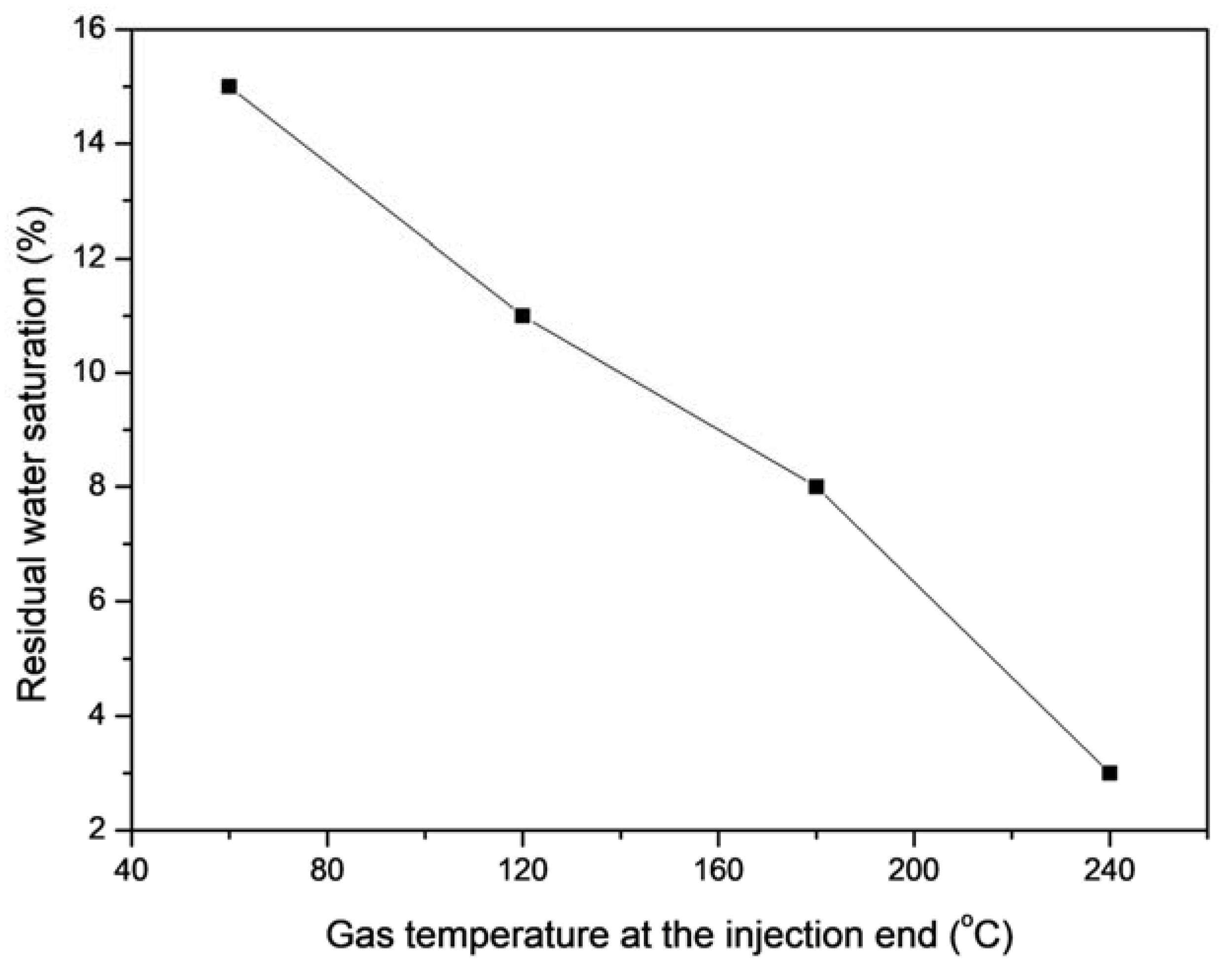
| Ion Content (mg/L) | Total Salinity (mg/L) | Water Type | ||||||
|---|---|---|---|---|---|---|---|---|
| Ca2+ | Mg2+ | CL− | SO42− | CO32− | HCO3− | K+ Na+ | ||
| 14.85 | 7.48 | 2266.88 | 54.1 | 197.66 | 2160.08 | 2428.01 | 7156.5 | NaHCO3 |
| Parameters | Values | Meaning |
|---|---|---|
| 0.1033 | Rock porosity | |
| 0 | Source term of seepage field | |
| 868 J/(kg.K) | Specific heat capacity | |
| 3.8 W/(m.K) | Heat conduction coefficient | |
| 11 mPa.s | Viscosity |
Publisher’s Note: MDPI stays neutral with regard to jurisdictional claims in published maps and institutional affiliations. |
© 2022 by the authors. Licensee MDPI, Basel, Switzerland. This article is an open access article distributed under the terms and conditions of the Creative Commons Attribution (CC BY) license (https://creativecommons.org/licenses/by/4.0/).
Share and Cite
Yang, Z.; Liu, H.; Guo, C. Experimental Study and Numerical Simulation of Removing Water Blocking by Hot-Gas Injection in Tight Cores. Energies 2022, 15, 6119. https://doi.org/10.3390/en15176119
Yang Z, Liu H, Guo C. Experimental Study and Numerical Simulation of Removing Water Blocking by Hot-Gas Injection in Tight Cores. Energies. 2022; 15(17):6119. https://doi.org/10.3390/en15176119
Chicago/Turabian StyleYang, Zhao, Hongji Liu, and Chaohua Guo. 2022. "Experimental Study and Numerical Simulation of Removing Water Blocking by Hot-Gas Injection in Tight Cores" Energies 15, no. 17: 6119. https://doi.org/10.3390/en15176119






